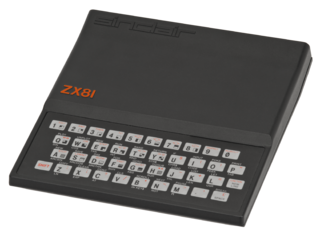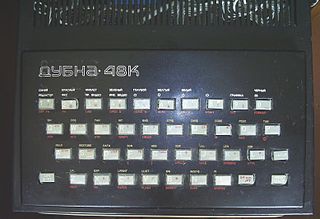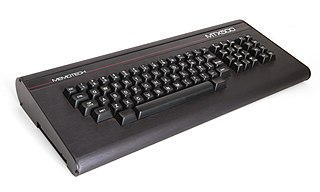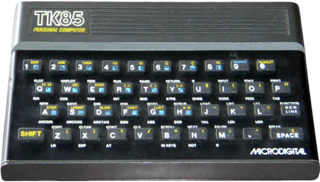
The Sinclair ZX80 is a home computer launched on 29 January 1980 by Science of Cambridge Ltd.. It is notable for being one of the first computers available in the United Kingdom for less than a hundred pounds. It was available in kit form for £79.95, where purchasers had to assemble and solder it together, and as a ready-built version at £99.95.

The ZX Spectrum is an 8-bit home computer that was developed by Sinclair Research. It was released in the United Kingdom on 23 April 1982, and became Britain's best-selling microcomputer.

The ZX81 is a home computer that was produced by Sinclair Research and manufactured in Dundee, Scotland, by Timex Corporation. It was launched in the United Kingdom in March 1981 as the successor to Sinclair's ZX80 and designed to be a low-cost introduction to home computing for the general public. It was hugely successful; more than 1.5 million units were sold. In the United States it was initially sold as the ZX-81 under licence by Timex. Timex later produced its own versions of the ZX81: the Timex Sinclair 1000 and Timex Sinclair 1500. Unauthorized ZX81 clones were produced in several countries.

Aquarius is a home computer designed by Radofin and released by Mattel Electronics in 1983. Based on the Zilog Z80 microprocessor, the system has a rubber chiclet keyboard, 4K of RAM, and a subset of Microsoft BASIC in ROM. It connects to a television set for audiovisual output, and uses a cassette tape recorder for secondary data storage. A limited number of peripherals, such as a 40-column thermal printer, a 4-color printer/plotter, and a 300 baud modem, were released. The Aquarius was discontinued in October 1983, only a few months after it was launched.

The TK90X was a Brazilian ZX Spectrum clone made in 1985 by Microdigital Electrônica, a company from São Paulo, that had previously manufactured ZX80 and ZX81 clones.

The Apple II home computer series was frequently cloned, both in the United States and abroad, in a similar way to the IBM PC. According to some sources, more than 190 different models of Apple II clones were manufactured. Most could not be legally imported into the United States. Apple sued and sought criminal charges against clone makers in more than a dozen countries.

TK82C was a Sinclair ZX81 clone made by Microdigital Eletrônica Ltda., a computer company located in Brazil.

The Dubna 48K is a Soviet clone of the ZX Spectrum home computer launched in 1991. It was based on an analogue of the Zilog Z80 microprocessor. Its name comes from Dubna, a town near Moscow, where it was produced on the "TENSOR" instrument factory, and "48K" stands for 48 KBs of RAM.

The TK 95 microcomputer was a 1986 ZX Spectrum clone by Microdigital Eletrônica, a company located at São Paulo, Brazil. It was an evolution of the TK90X introduced the previous year.

The Memotech MTX500 and MTX512 were a range of 8-bit Zilog Z80A based home computers released by the British company Memotech in 1983 and sold mainly in the UK, France, Germany and Scandinavia. Originally a manufacturer of memory add-ons for Sinclair machines, Memotech developed their own competing computer when it was perceived the expansion pack business would no longer be viable.

The TK85 was a ZX81 clone made by Microdigital Eletrônica, a computer company located in Brazil. It came with 16 or 48 KB RAM, and had a ZX Spectrum–style case, similar to a Timex Sinclair 1500.
Ringo R-470 was a Brazilian clone of the Sinclair ZX81 by Ritas do Brasil Ltda. introduced in 1983. It featured a Z80A processor at 3.25 MHz, 8K ROM and 16 KB RAM. It wasn't 100% compatible with the ZX81, and some BASIC tokens have alternate codings.
The Dismac D8000 was the first personal computer manufactured in Brazil in 1980. It was also the first Brazilian TRS-80 Model I clone.

The MC-1000CCE Color Computer was a home computer produced in Brazil by CCE and released in February 1985. The machine shares some heritage with the GEM 1000 and the Rabbit RX83, systems produced in Hong-Kong by the firm "Rabbit computers”. The machine was sold up to 1986.

Prológica Indústria e Comércio de Microcomputadores, commonly shortened to Prológica, was an influential Brazilian microcomputer company that reached its peak in the mid-1980s, when it ranked third among national companies in the sector.
The TK80 was a home computer produced by Microdigital Eletrônica. A clone of the Sinclair ZX80, it was introduced along with the TK82C in 1981 during the "I Feira Internacional de Informática". There were two versions, one with 1 KB RAM costing Cr$ 68,850 and another with 2 KB costing Cr$73,650.
The NE-Z80 was a homebuilt computer kit presented by Nova Eletrônica magazine on the October 1981 issue, a publication that was part of the Brazilian Prológica group.

The AS-1000 was a Brazilian clone of the Sinclair ZX81 introduced by Engebrás Eletrônica e Informática Ltda in October 1983. The main differences regarding the ZX81 are the internal power supply and larger RAM. The machine had an initial retail price of Cr$ 195 000.















